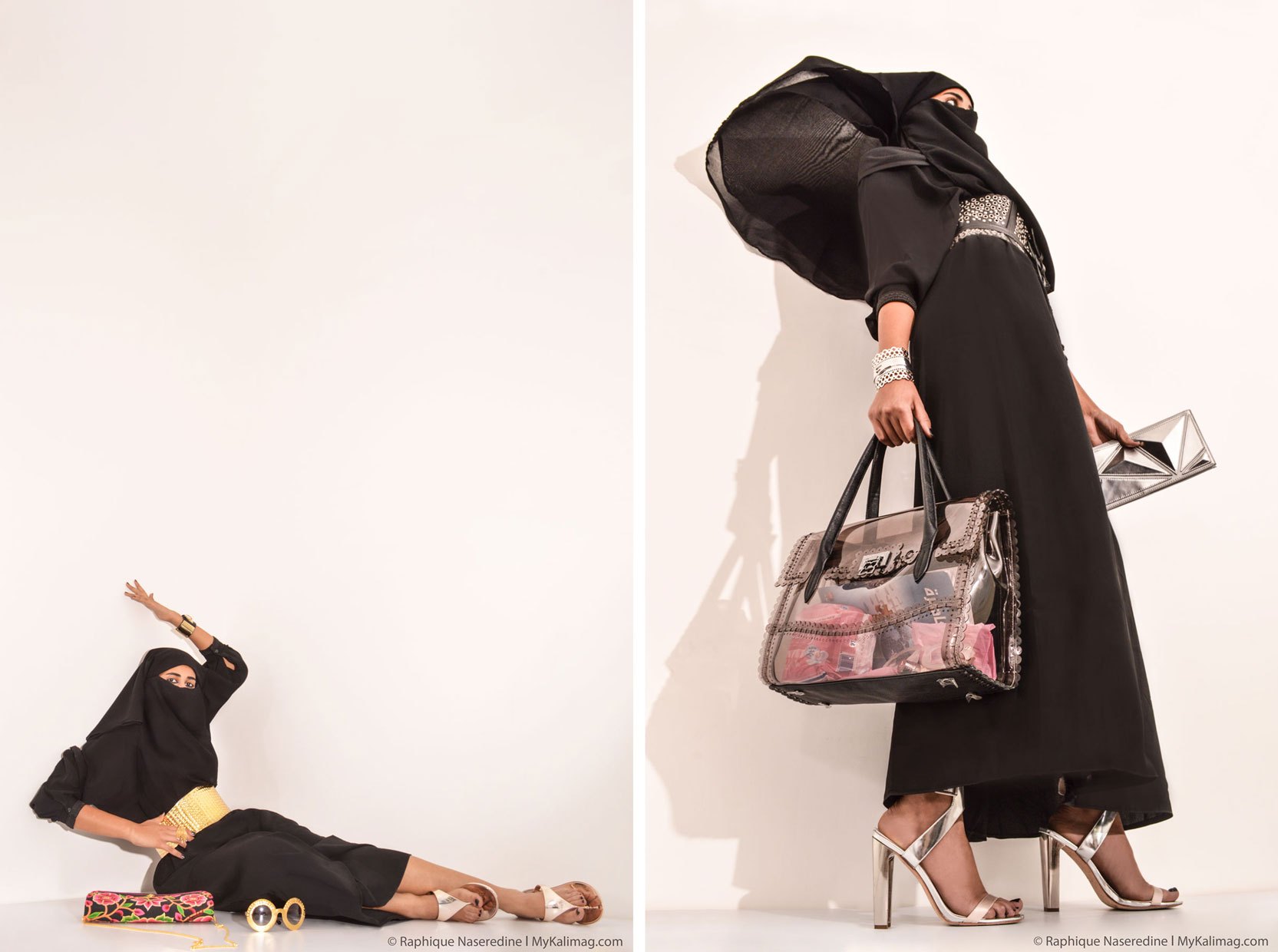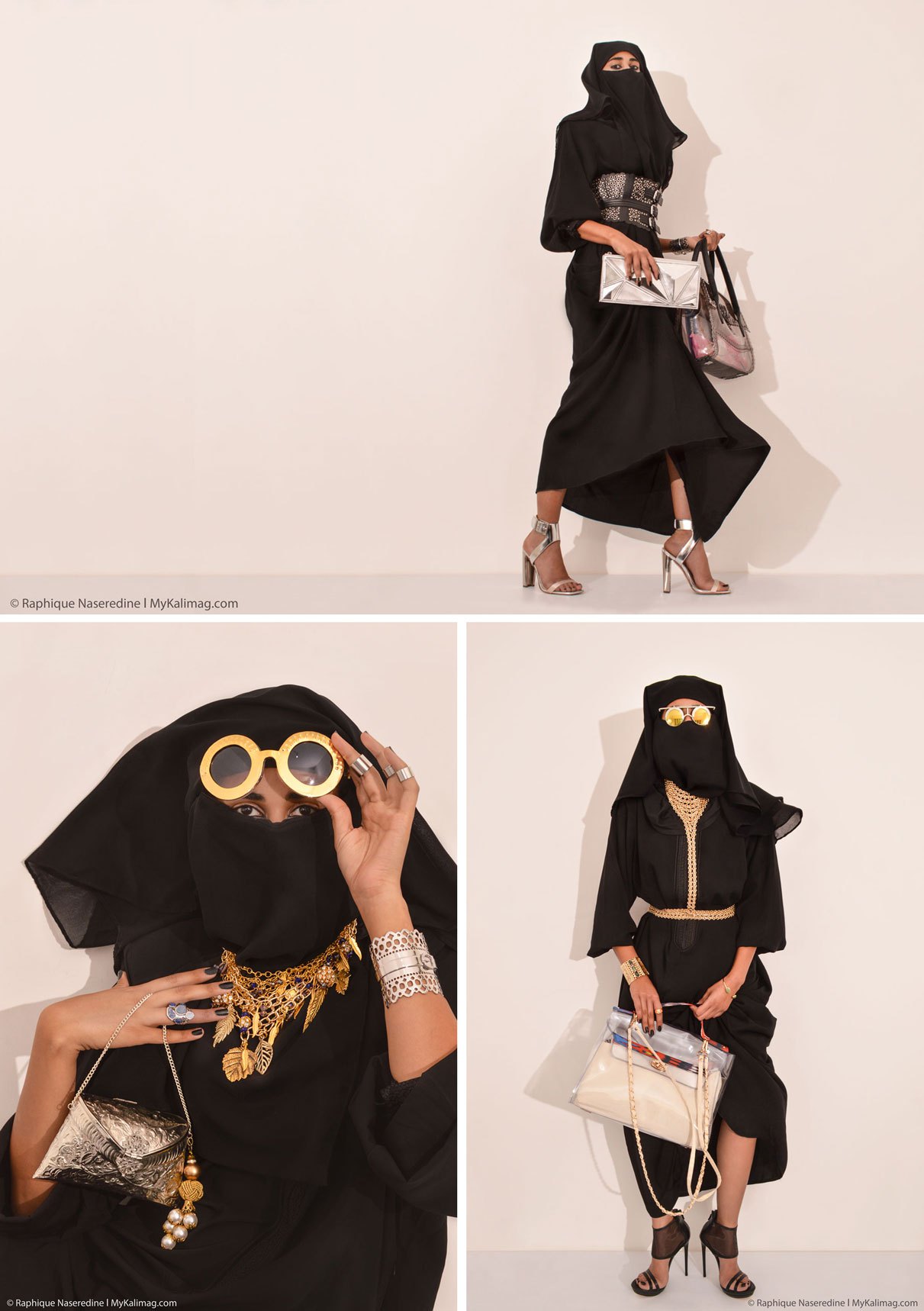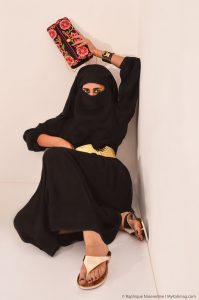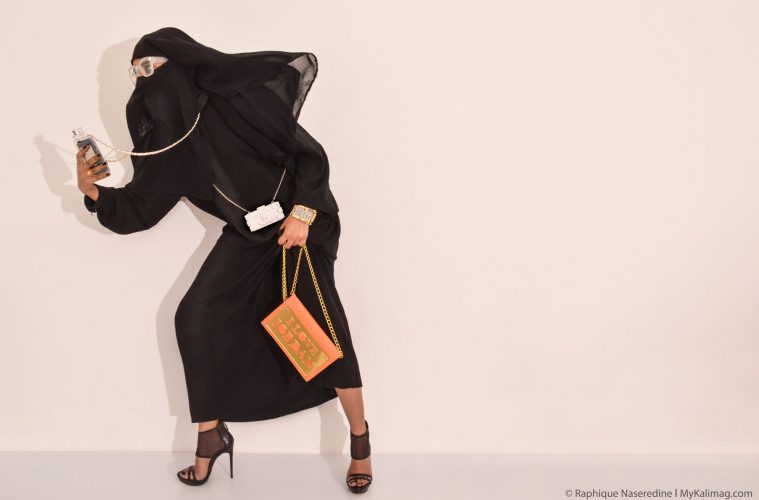By A.W. Rahmaan*
Sitting editor: Eliza Marks
Photographed by: Rafic
Model: Razan
Make-up by: Amer Atta
Styled by: Fadi Zumot
Art directed by: Khalid Abdel-Hadi
Special thanks for Ark Photography for the lights
Amman – Jordan
Questions of the meaning of modernization become increasingly important as the Middle East is catapulted into the global interactions. From a western perspective, this movement is closely associated with the transition from “traditional” to “modern” values. Women are often central to these conversations as figures who often carry culture and pass it onto the next generation. But, are women truly making their own decisions when negotiating traditional expectations and large-scale social development and “progress”?
The use of social media has increased dramatically over the past 10 years and become a major component of the average Jordanian’s life. It is now an essential tool for women to demand their rights, especially following the outbreak of the Arab Spring. Facebook pages like “The uprising of women in the Arab world” and “My mother is Jordanian and her nationality is a right for me,” and Twitter handles like “#weneedfeminism” were created to aid in advocacy, and video bloggers and Instagram hijab fashionistas who use social media to express their views and beliefs. Some women turn to social media to find support because gender inequality was still being overlooked during the reform movements of the Arab Spring. We can see an increasing online discussion of feminist issues and other advancements toward a modern and open society, but do women actually have choice about their most personal form of expression, the way they dress, in the real world? Let’s look to Jordan and the changing meanings of the Hijab.
The Arabic word, Hijab, is literally translated to mean veil. Mainstream Jordanian-Muslim understandings of hijab dictate that a woman should cover her body entirely except her hands and face, and that this is based on a specific Hadith, a verse that considers the life of the Prophet, and and Quranic verse. In the past, woman wore hijab to distinguish themselves from slave women. Slave women were naked from the belly button up. Frankly, free women before Islam wore hijab, too. The Qur’anic hijab verse,Q 33:59, which includes direct conversation with the prophet’s wives only who wore it to distinguish themselves from other women and to avoid harassment, is also central to this discussion.
Let’s now consider the “obligatory” aspect of the hijab and what it means, today. What should it look like? What does it symbolizes? How should it be worn and by whom? Do women actually have to wear it? While views of hijab differ greatly, it is generally understood to be a religious symbol, and many Muslim women believe that hijab is a religious obligation, even if they do not wear it themselves. Other pro-hijab arguments include the obligatory “if you want to go to heaven,” the persuasive “do you want to be a lollipop without a cover and allow flies to eat you?,” and the coercive “respect yourself and your family… have some dignity.” any young women of diverse backgrounds still choose to wear hijab, and redefine it to fit different contexts. [Just a side note: Though it is socially neglected, men should also wear a type of hijab and act modestly if one considers the same verses.]

Left: I love Jordan clutch by Kay, Dior and Chanel phone cases and bejewelled glasses, all Pink Dust. Mesh heels, cuffs and ring; BCBGMAXAZRIA. Right: Sunglasses and hand bag both from Pink Dust. Body necklace, cuff, bracelet, ring and mesh heels BCBGMAXAZRIA. Abaya and veil worn throughout, stylist’s own.
.
Jordan, as a country, is perceived and defined as a “religious, yet liberal” country that exhibits both modern and traditional/tribal aspects. For example, there are large urbanized cities such as Zarqa, Amman, Irbid and Aqaba that are economically developed and show many elements of modernization and urbanization to varying extents, including developed infrastructure, educated masses, privatization, and the involvement of a foreign open market. These cities form a sharp contrast to other municipalities that are generally smaller in size, continue to be focused on local economies, and remain more traditional in their social values.
Amman is arguably the most modernized and urbanized city in Jordan, and there are many family photos of the earlier generations that show women wearing short skirts, bell bottom pants, tight jeans, shorts and tight shirts, had all kinds of hairstyles. Since then, Jordan’s population has grown significantly and diversified, bigger and better schools and universities have been built, there have been major investments in infrastructure and shopping malls. All of this might suggest a continued move away from traditional religious markers, and yet, the opposite is true. Why is this?
When people discuss religion, they often describe it as if it were an unchangeable truth that is neither vague nor fluid. However, religion does not exist in a vacuum and is influenced by the world around us. Cultures, traditions, politics, gender and sexuality are all influential parts of one’s identity, and that affects his/her/their perspective and interpretation of religion. In other words, religion is as fluid and personal as identity. The debate over values derived from religion is not whether they are divinely given, but rather that they are humanely interpreted.

left: Golden pleated belt and sunglasses, hand embroidered clutch by designer Hana Hani Dakhgan cltuch, both from Pink Dust. Cuff and golden sandals both BCBGMAXAZRIA. Right: Leather corseted belt, see-through handbag, silver heels, silver cultch and silver cuff, all BCBGMAXAZRIA. Abaya and veil worn throughout, stylist’s own.
.
In Jordan, the Muslim Brotherhood emerged from both groups which make up a substantial part of the Jordanian society: the Trans-Jordanian and the West Bank Palestinian. The Association of the Muslim Brotherhood was officially established in 1945, and became radical in the 1970s following the Egypt-Israel peace processes, the Islamic Revolution, and closening relations between Jordan and the US. The Brotherhood’s ideology shifted from one that did charitable work and provided social services with a political arm, to the point that it was no longer compatible with the parliamentary political system and antithetical to democracy. The group aggressively advocated for the implementation of “the true” Sharia law, continued to garner strong support for social justice work. But, the politicization of Islam like that of the Brotherhood resulted in the misunderstanding of religion as being a monolithic entity.
The Hijab was caught up in this changing view of religion and politics, and the so-called “Islamic” revival and increasing influence of the Islamic Brotherhood in Jordan contributed to its increasing importance in society.
The major liberal argument against Islam is that the Quran is a patriarchal text, and that male dominance in Islamic scholarship has led to a number of misconceptions and misinterpretations. Male needs and concerns are central to discussions of the hijab, what it is, and who should wear it. This can be seen in two major arguments for the hijab made by males in Jordan: (a) Women should wear hijab in order to protect themselves from sexual harassment, which is an unfortunate but justified act that is symptomatic of men’s inability to control their sexual urges; and (b) Women should cover to preserve the honor of the family and her own respectability. Both of the above arguments come from males’ patriarchal needs to protect themselves from being held accountable for harassment to to uphold their “honor, – and treat women primarily as an instrument to achieve an end.
“…people might believe that there is a causative relationship between growing up in the city and wearing the hijab, that growing up in the city would negate one’s religious affiliations or perceived obligations.”
.
.
The above mentioned lollipop analogy, which compares women who have chosen to wear the hijab are related to a covered lollipop protected from the onslaught of flies, and women who do not cover their hair to an exposed and dirty unwrapped lollipop, is remarkably un-nuanced. This and similar analogies that compare the hijab to an iPhone cases and rotten apples prompted women to take a stand. They used social media to speak against such campaigns, and to voice their experiences of being on the receiving end of such an arguments. A group of Muslim American women uploaded a viral video entitled “A Man’s Hijab,” which shows some pious sisters leading a parody jalsa (a meeting for debate) to satirize the logic of how a male led society convinces women of their hijab. Arguments range from hiding one’s fitna (temptation) causing dimples among men, to the need to be wary of growing a beard for the purpose of hotness or Sunna.
The above is just one example of women reclaiming and redefining understandings of hijab by questioning of preconceptions of womanhood and women’s place in society, socially and religiously. Hijab, today, takes many forms and fulfills many purposes, from the religious to the political to the development of cultural identity, and these new meanings are asserted in each new debate about it.

Clockwise, Top image: Leather corseted belt, see-through hand bag, silver heels, silver cultch and silver cuff, all BCBGMAXAZRIA. Image left: Necklace by The Handmade Dealer. Clutch and gold-pleated glasses both from Pink Dust. Silver cuff, and rings, all from BCBGMAXAZRIA. Right: Sunglasses and hand bag both from Pink Dust. Body necklace, cuff, bracelet, ring and mesh heels BCBGMAXAZRIA. Abaya and veil worn throughout, stylist’s own.
.
The extent of controversy surrounding the hijab can be seen in responses to Egyptian singer, Haitham Sa’eid’s, 2005 music video, “Homma Malhom,” which features a Hijabi female model. The song’s title reflects the video’s theme: “Homma Malhom” translates to “what is their business?.” The video is inspiring for young impressionable girls and depicts issues of Cairo at the time such as secret romances between hijabi girls and their secret boyfriends. It was frankly revolutionary despite the backlash it received aboutthe model’s behaviour and how she wore the hijab One Youtube comment responded with a further critique, writing, “You will never be satisfied with anything. Whether naked or wearing a veil, is not different to you. We are a strange society! And just because she’s veiled, wearing jeans and not an abaya on her means her Hijab is not valid? And showing her hair with revealing clothes is fine and you all would like that?” Another comment highlighted the clip’s impact, saying, “The first and last clip to show a veiled girl.”
A 2013 video showing Muslim women in New York explaining the diversity and fluidity of what hijab means to them is another example of women using online media to speak out against hegemonic interpretations of the hijab. In the video, these “Mipsterz” – short for Muslim hipsters- break stereotypes of how a Muslim women “should” act and dress like while skateboarding, modeling, and roaming the streets of New York to Jay-Z’s song “Somewhere in America.“ It is is another relevant and effective example of women re-defining and reclaiming the hijab in an urban context! Although the video, directed by Muslim women and published by Sheikh & Bake Productions, has garnered a lot of support from Muslim millennials around the world, it received viral backlash from Muslims, especially in the Arab world, who believed in a singular understanding of Islam and how hijab should be worn. These mipster city women made it clear that certain understandings of Islam do not define them, and they used their agency to understand of the hijab as their choice and part of their modern urbanized lifestyle and identity.

Golden pleated belt and hand embroidered clutch by designer Hana Hani Dakhgan cltuch both from Pink Dust. Cuff and golden sandals both BCBGMAXAZRIA.
Some “Modernized and Western” people might believe that there is a causative relationship between growing up in the city and wearing the hijab, that growing up in the city would negate one’s religious affiliations or perceived obligations. But this is not the case in Jordan. In this country, being urban does not mean one turns away completely from religion and tradition, which remain essential to society.
Again, women in Amman, like anywhere else, wear hijab for various reasons. I am a Jordanian woman who wears hijab and has many discussions with other hijabi women on the subject, and I can say with confidence that there are women who do choose hijab as a religious obligation, and they are also “modern women.” . There are also those who do not believe that hijab is an obligation, but wear it as a means to maintain the family honor and avoid sexual harassment. And there are others, most of whose mother’s don’t wear hijab, who see hijab as not a religious obligation but rather sign of social oppression.
The main problem in this discussion is that many Jordanians simply inherit their ideas from the generations before them, and do not recognize that how they perceive “man” and “woman” and the roles associated is socially constructed. We must ask ourselves how we gain the knowledge, and the manner in which we gain that knowledge! The argument lies whether women are actually making active choices remains open and something we must continue to consider.
.
My.Kali on Instagram
.

